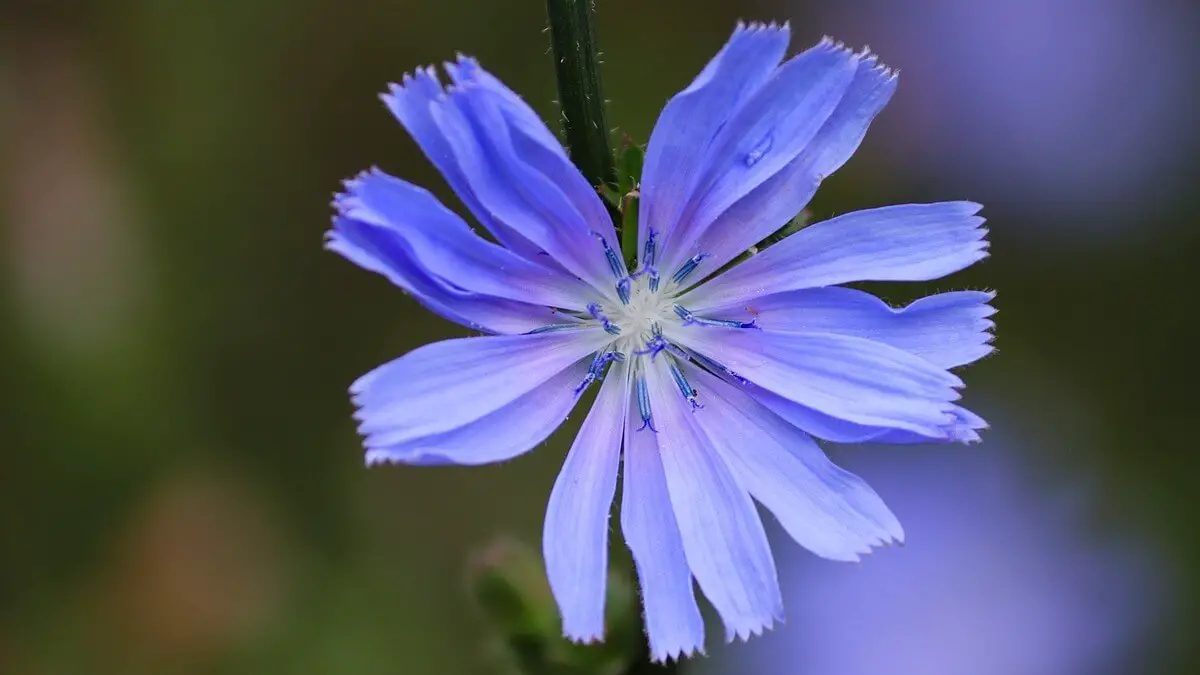Growing Chicory Plants in Gardens
Common Chicory (Cichorium intybus) has many names including blue daisy, blue sailors, blue weed, cornflower, and coffee weed. This species belongs to the Asteraceae family. Growing chicory plants in the garden bring in commercial benefits too.
This article focuses on growing chicory plants in gardens, propagation, caring, harvesting, and its uses.
Generally, chicory is a perennial herbaceous plant. The flowers of this plant are mostly bright blue in color. In rare cases, you can find them in pink or white in color.
There are many varieties of these plants grown especially for chicons (blanched buds), salad leaves, or roots. Mostly, consumers bake or ground these parts. After that, they use them usually as a food additive or coffee substitute.
In the modern days, insulin (a chicory root extract), serves as a dietary fiber source and sweetener in food industries. It also serves as a forage crop for many domesticated animals.
This plant is native to Europe. You can find them growing roadsides there. However, these plants have naturalized themselves in Australia, China, and North America nowadays.
In the United States, another curly leafy vegetable called endive (Cichorium endivia) also shares the common name “chicory” with Cichorium intybus. These two species have close relations. Some people mistake them very often for each other.
Table of Contents
History
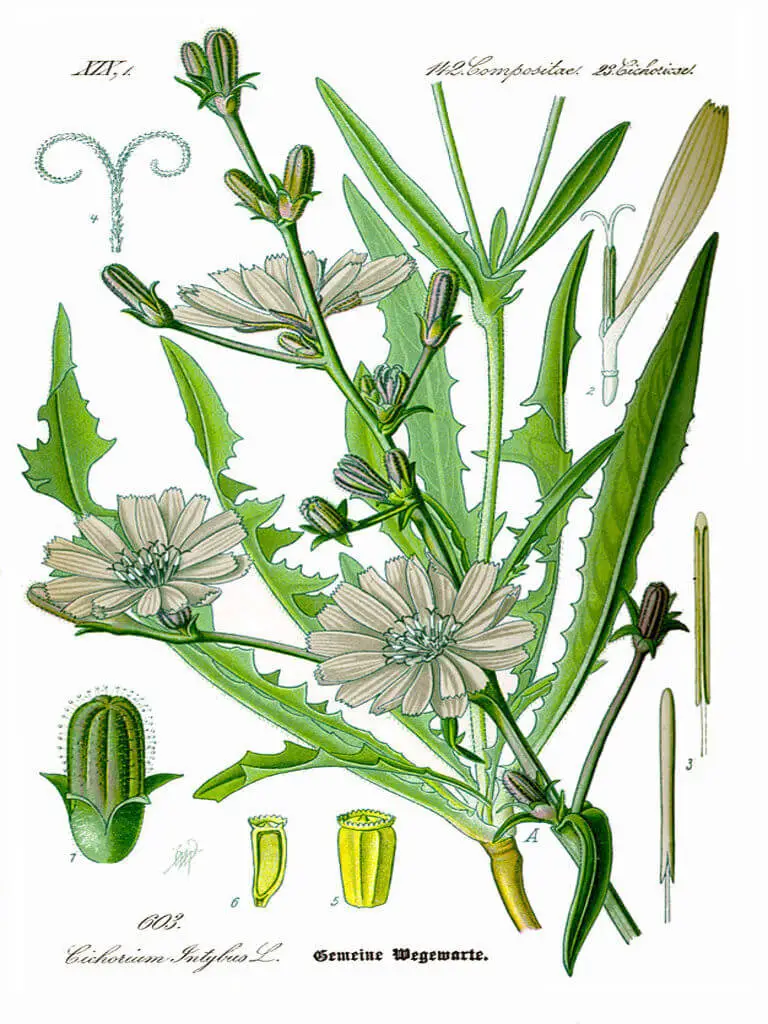
The native roots of these plants are traced back to western Asia, North Africa, and Europe. The history of Cichorium Intybus originates from ancient Egypt. Ancient Romans have grown chicory plants for consumption. Historical documents Cleary indicate these facts.
During the 16th century, Europeans first tasted coffee drinks on Malta Islands. Dutch started adding chicory with coffee to enhance its taste and ‘lively feel.
The ruler of Prussia, Frederick II banned coffee imports in 1766. This led to the development of a coffee substitute by Christian Gottlieb Förster (innkeeper of Brunswick city).
Later, he manufactured the coffee substitute using chicory as the main ingredient at Brunswick and Berlin in 1769-70. He installed about 22-24 such factories in Brunswick alone.
During the Napoleonic Era, the French cultivated chicory as a potherb. They used it as a coffee substitute. In the United Kingdom, the traders sold Camp Coffee (a chicory and coffee essence) since 1885.
The Confederate soldiers also adopted chicory as a coffee substitute during the American Civil War. The New Orleans port became the second-largest coffee importer (after New York) by the 1840s. However, the Union naval blockades cut off the port during the American Civil War.
So, the Louisianans started adding chicory root to their coffee to deal with the scarcity. The long-standing tradition of adding chicory to coffee began in the United States. You can see this tradition even today in the US.
When the British colonized India through their east India company, they transported these plants there. Soon, chicory gained popularity as a delicious brewed hot drink in India and its surrounding areas.
Description
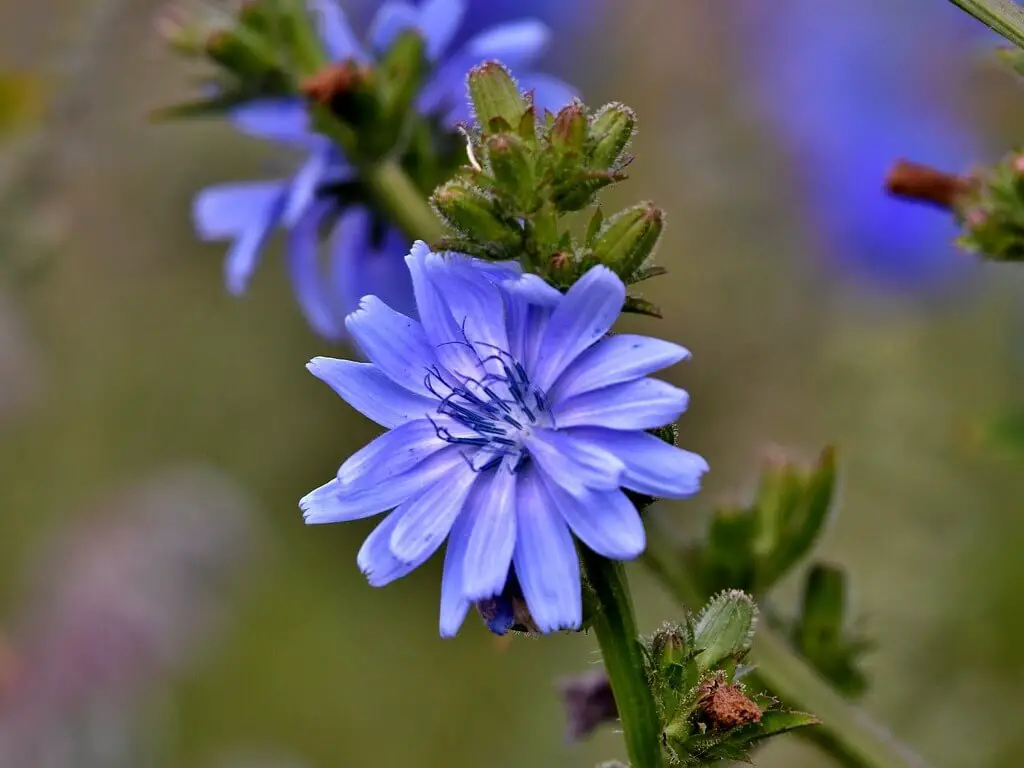
Growing chicory plants in gardens attract many onlookers. Normally, these flowers grow 3⁄4 to 1 1⁄2 inches wide. They appear mostly in light blue color. Sometimes, you can find them in pink or white colors also. However, this instance occurs very rarely.
Normally, the flowering season is from July to October. This period may vary a little bit depending on the environment.
Almost all the plants in the aster family, including chicory, open and close the flowers corresponding to the sun’s movement.
The flower heads of this plant open with sunrise and close during the afternoon times. The closing process starts when the sun is directly above the plant and ends within a few hours.
In addition, the flowers open with a dark blue-lavender color and lighten out with the sky as the day passes.
Normally, the bees and butterflies visit the flowers in the early morning for pollination. Every individual bloomed flower falls off within a couple of days.
In the late year, pollinated flowers develop fruits. These fruits usually fall on the ground within a few days. Thus, the seeds in the fruit germinate and start to spread.
These plants can grow 10 to 40 inches tall. While flowering they develop grooved, tough, and hairy stems. The leaves are usually unlobed, lanceolate, and stalked.
The involucral bracts sprout out in two rows. The outer ones are short and wide. The inner ones are long and erect.
These plants have long taproots. Both the taproots and leaves are edible. They are rich in nutrition.
Propagation – Growing Chicory Plants
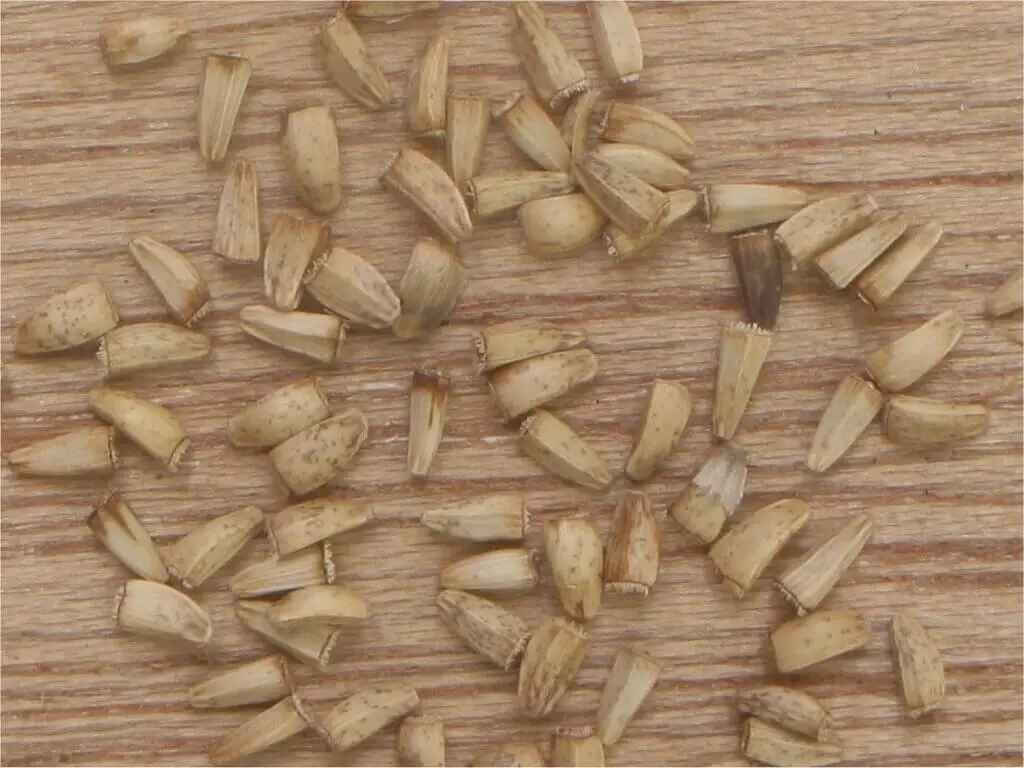
Photo by Rasbak (Wikimedia Commons) (CC BY-SA 3.0)
Cichorium Intybus (Chicory) can adapt well, even as self – seeding plant in USDA Zones 3 – 10.
Mostly, gardeners growing chicory plants, grow it for roots or leaves.
If you grow it for roots, prepare the soil crumbled and loose. You can also add sand to improve the drainage. chicory (Cichorium Intybus) is can grow in almost any soil type. Still, adding compost encourages its healthy growth.
If you grow it for leaves, make sure to amend the soil with nitrogen-heavy fertilizer at seeding time. This plant can serve as a good fodder crop.
Growing Chicory Plants From Seeds
Growing chicory plants from seeds is an easy way of propagation. You can buy seeds online or from any nurseries nearby. You can expect a large yield during harvest, in this propagation method.
Select a location with full sunlight. These plants can thrive in partially shaded locations also.
Start the sowing process in the spring season. These seeds require some light for germination. Hence, do not bury them too deep. Just 1/4 inch deep sowing is adequate for germination.
Maintain soil moisture during the initial stages. Make sure not to overwater, so as to cause waterlogging. You can expect germination in about 2-3 weeks’ time.
Although these plants can germinate at different temperatures, 40 – 85 degrees Fahrenheit is the optimal temperature range. Within the range, around 70-degree Fahrenheit is the most ideal temperature for germination.
After germination, the young fresh plants start to pop up. Thin them to a foot apart, pulling out unhealthy ones.
You can also opt to plant the next batch of plants during summer. But make sure the temperature is under 85 degrees Fahrenheit. Above this temperature, the germination success rate drops.
Maintenance – Growing Chicory Plants

Photo by Harry Rose (Wikimedia Commons) (CC BY 2.0)
Chicory plants prefer to grow under full sun. Make sure they get at least six hours of sunlight every day, though they can thrive part shade. This simply means you have to select space accordingly while sowing seeds.
Chicory plants prefer to grow in well-draining fertile soil with a PH between 5.5 – 7.0. In this type of soil, they develop more leaves and healthy roots. They also prefer to grow in open or distributed areas like pastures, meadows, large spaces, and abandoned lands.
Keep a watch on soil moisture. Water the plants regularly, so that the soil gets at least an inch of water every week. Never allow the soil to get completely dry, especially during the initial stages.
These plants do not pollinate by the wind like dandelions. So, they cannot shoot up in random places. However, if birds or bees transport the seeds, they can pop up in random spaces. But this occurs very rarely.
This simply means you do not have to bother their spread as you do with dandelions. However, they can sprout out in spaces near plants when the plant fruits drop. So, keep a watch on these areas and pull out unwanted sprouts.
Use a good weeder to dig up and remove the unwanted plants. Make sure you remove the entire plant including the taproot, out of the ground.
Cut out the flowers after they finish blooming using a good quality shear. This prevents reseeding.
Varieties of Chicory
You can grow chicory for leaves or roots. Most people call leaf chicory as endive. In fact, the true endive (Cichorium endivia) is totally different species. We have explained some varieties below:
Radicchio
This variety usually has green or red leaves. Some people only refer to the red-leaved (white-veined) type as radicchio. It is commonly called red chicory.
Sugarloaf
This variety looks similar to cos lettuce. It has tightly packed leaves.
Belgian endive
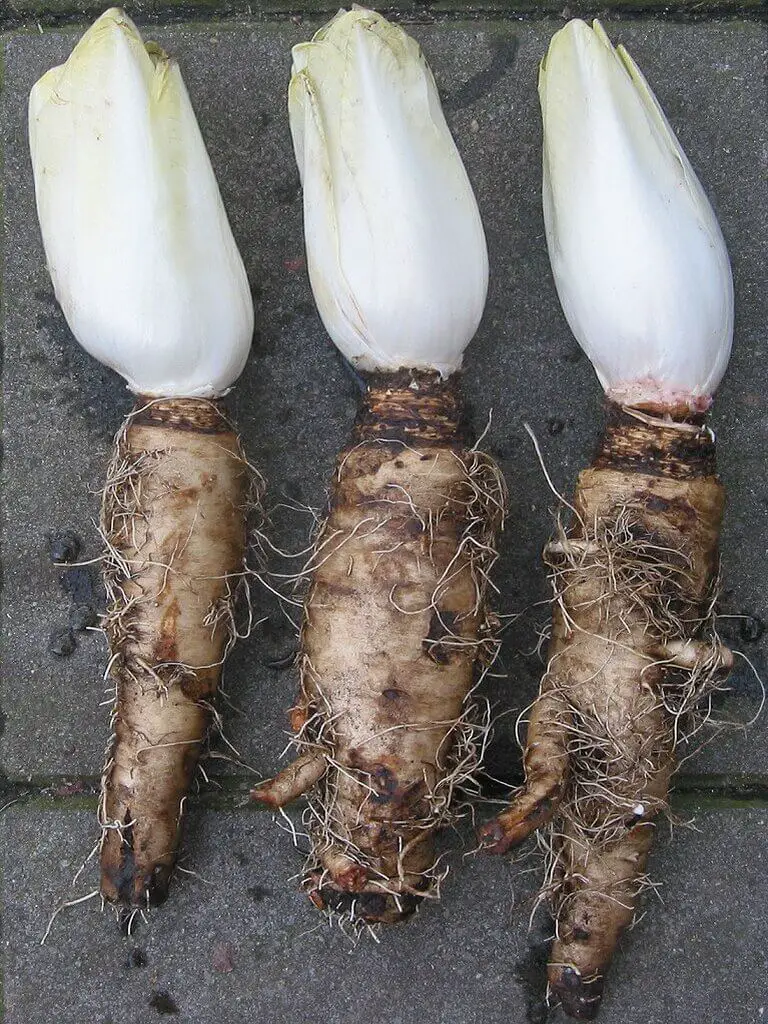
Photo by Rasbak (CC BY-SA 3.0)
This Variety is called witloof or endive in the United States. It appears with a head of bitter leaves, usually cream-colored. It grows entirely underground. Hence the leaves do not turn green or opening up (etiolation).
Catalogna chicory
This variety is known as puntarella in Italy. It includes a whole subfamily of chicory plants.
Magdeburg
This is a traditional variety of chicory. Normally, these plants mature in about 3 – 4 months. They have large, strong, and healthy roots. Mostly, gardeners grow this variety for roots. These roots serve as a coffee substitute in the food industry.
Forage chicory varieties
There are Some exclusive varieties grown especially for forage. Some of them Include Puna, Puna II, Oasis, Grouse, Forage Feast, Choice, and Six Point
Pests and Disease
While growing chicory plants, look out for bugs regularly. Water to the base of the plants rather than misting on foliage. Make sure the soil is well-draining. That’s all.
Generally, pests and diseases do not bother these plants regularly. Avoid planting other cultivated leaf chicory varieties like radicchio and endive, near these plants. It is because they share most of the same diseases and pests. If one plant is infested, other plants may attract the infestation easily.
Pests
The common pest that bothers these plants are mostly slugs and aphids. You can treat them easily as there are a variety of treatments available.
Slugs
Slugs love to feed on Cichorium Intybus foliage. But dealing with them is easy.
Naturally, you can pour garlic oil around the plants. Natural copper salts, Vaseline and salt paste, etc, are effective natural repellents.
Coffee grounds (caffeine) are proven to be one of the highly toxic materials to slugs and snails.
If they are few in numbers, you can simply remove them by hand. You can also use traps to catch them.
Aphids
In General, the Cichorium Intybus plants are vulnerable to a variety of aphid species. However, the small chicory aphid variety called Aphis intybi, commonly affects these plants
These Aphids suck the sap out of the foliage in crowds. As result, the plants suffer stunt growth and the foliage turns yellow or distorted.
You can treat the affected plants with a mixture of water and dish soap drops. This is adequate to deal with Aphids in most cases.
Alternatively, you can treat the affected plants with horticultural oils, insecticidal soaps, Neem oil Etc., Make sure to go through the application instructions that come with the package.
If you prefer a more easy way, just use aphid spray on the affected plants. It is advisable to always keep a guide handy to treat pests.
Diseases
Cichorium Intybus gets affected by diseases mostly during warm and moist climates. So, always keep a watch on these plants in the summers.
Generally, it is advisable to water the base of the plants rather than misting on foliage. Always water the plants in the mornings. So that, the plants have enough time to dry out themselves before the cool evenings arrive.
Anthracnose
This soil-borne disease is common among the daisy family plants. It is caused by a fungus called Microdochium panttonianum.
This disease causes tan or greyish spots on foliage. Finally, these spots merge themselves and turn necrotic. Mostly, this disease affects plants in warm and humid conditions.
There is no specific cure for this disease. So, remove the affected plant as a whole and destroy it completely.
Hence, it is advisable to remove the weeds regularly. Practice rotation of crops. These will prevent Anthracnose infection in plants for the most part.
Fusarium Wilt
Fungi (Fusarium genus) causes this disease. It affects plants in warm and moist conditions. It causes the plants’ foliage to turn yellowish and droop down finally.
If your soil has more nitrogen content, this soil-borne disease may affect the plants.
Dispose of the infected plants and weeds immediately. If you suspect more plants infected with the disease, go for fungicide mycostop treatment.
Bacterial Soft Rot
Normally, this bacterial disease causes lesions on plant foliage which cracks and oozes a tan or black liquid. This summer disease has no cure.
So, always use good quality garden tools and wash them every time before and after usage. Treat aphids immediately, as they can spread this disease to other plants.
Harvest – Growing Chicory Plants

Roots
Generally, these plants flower within 3 – 4 months after seeding. You can harvest the roots after flowering. Usually, after a year, the roots grow woody. So, it is advisable to harvest the roots when they are tender, within the first year itself.
Just dig a few inches around the plant with a good quality shovel. After that, pull out the long taproot.
Leaves and Flowers
It is best if you pluck the young leaves, especially before flowering. After maturing, the leaves will become more rigid. As for as flowers are concerned, you can pluck them any time after blooming.
Preserving – Growing Chicory Plants

Photo by Herbeater (Wikimedia Commons) (CC BY-SA 4.0)
You can use the preserved roots as a coffee substitute. Just clean them in running water and scrape the skin away. After that, cut them into long pieces, typically an inch.
Until the roots turn brown, roast them in a pan or an oven. If you use a pan, turn the roots occasionally. This facilitates even drying throughout them. After drying completely, the roots emit an odor similar to coffee. At this stage, stop frying and take the roots out. If you use an oven, make sure to warp them in a cookie sheet and set the temperature to 325 F
This process may last up to a couple of hours depending on the thickness of the roots.
After that, place the roots on a plate and allow them to cool completely. Then, grind them as usual.
You can store the unwashed leaves in a sealed plastic bag in a refrigerator for a week. Wash them just before usage. Otherwise, they will not dry well and rot quickly.
It is best to use the flowers fresh. In case, if you want to extend their shelf life, soak them with vinegar.
Uses Of Growing Chicory Plants
Gardeners growing chicory plants enjoy a variety of uses. Some of them are described below
Coffee Substitute
The Cichorium intybus var. sativum (root chicory) serves as a coffee substitute and also as a coffee additive. European consumers use this plant root as a coffee substitute.
The Mediterranean region consumers roast, bake and ground the roots. They use the resultant powdery mix as a coffee substitute. In the United States (New Orleans), South Africa, and in some parts of Southeast Asia, consumers use root powder as a coffee substitute.
Leaf, Roots, and Forage
There are some varieties of Cichorium Intybus planted exclusively for roots, leaf, and forage. For example, gardeners grow Radicchio, Sugarloaf, Belgian endive, Etc., for leaves. They also grow varieties like Magdeburg for roots.
Some of the excellent chicory varieties to grow for forage include Puna, Puna II, Six Point, Oasis, Choice, Grouse, Forage Feast, Etc,
Traditional Medicine
The oils extracted from Chicory roots have various medical applications. In the field of traditional medicines, experts prepare Bach flower remedies using 38 medicinal plants. No wonder Cichorium Intybus is one among them.
Similar Plants
How to Grow Golden Zucchini in the Gardens
How to Grow Caraway Plants (Carum Carvi) in Gardens

